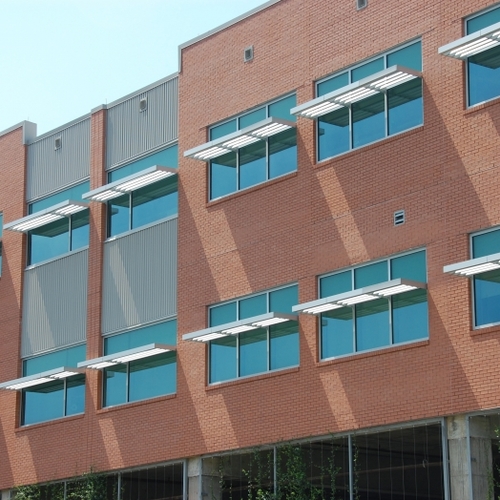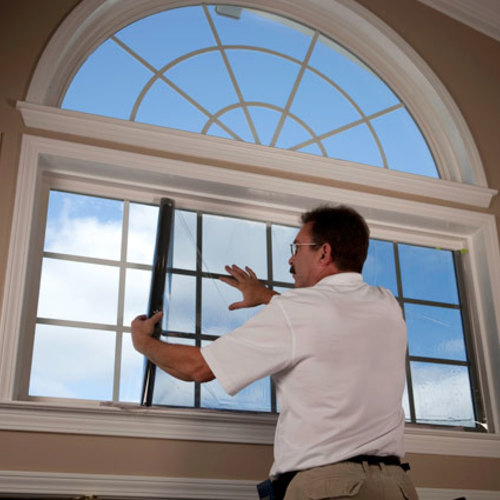
_Yes, but high-performance windows and exterior shading may save more_
While it’s theoretically impossible for anything to actually save energy, interior window shades can indeed keep summer heat out and winter heat in. The real questions then become: How well do they perform, and under what circumstances?
In the summer, shades keep out heat, but they also block light
Interior shades (and drapes, blinds, and the like) can reflect light energy back out that would otherwise be converted to heat energy inside the home. According to the authors of the best resource on the topic, Residential Windows (Carmody, Selkowitz, Arasteh, and Heschong), “drapes can reduce the solar heat gain coefficient of clear glass from 20 to 70 percent.” That’s a pretty big range. How well drapes exclude heat depends on the shade’s color (silver would be the best, black would be worst) and their proper use. They can’t block anything if they are not closed, and when they are closed, you of course can’t see anything out of the window, and you need to turn on a light inside (so, laws of thermodynamics notwithstanding, are they really saving energy?).
Exterior shading, on the other hand, performs better all around: It can deflect 100% of the direct solar gain, does not depend on occupant operation, and does not eliminate views. So, interior shades do work to reduce direct solar heat gain, they just do it rather poorly in the grand scheme of things.
In the winter, shades reduce radiant heat loss
You will see claims of up to R-8 by some manufacturers of interior shades in terms of reducing heat loss. Just as with insulation in a wall cavity, the insulating value of a window shade depends on a continuous air barrier being right next to it. How many of these interior thermal shades have an airtight seal around their perimeter? None that I have seen; instead, convective currents short-circuit the shades’ thermal performance. It is hard to say just exactly what their performance is, because there is no standardized third-party testing of window shades, as there is for windows. But be happy with a couple or so Rs, not R-8. And once again, you have to operate the shades to get their best performance. Leave them down or closed on a day that turns sunny, and you have a net loss of energy. Open or up at night—oops.
Interior shades can make rooms more comfortable. They have been shown to boost thermal comfort (raise the mean radiant temperature) by as much as 5°F. But just as with overall energy efficiency, improvements in thermal comfort with interior shades depend on how well the windows work to begin with. Improvements are highest and most noticeable with older, poorly performing windows. That bears repeating: Improvements are highest and most noticeable with older, poorly performing windows. Or put another way, good windows work better than shades.
So, interior shades can keep your house cooler in the summer (during the day) and warmer in the winter (at night). But for real energy savings and overall performance, go with high-performance windows and exterior shading, and relegate interior shading to handling privacy. After all, you put those holes in your walls for the views and the free light!
—Peter Yost is Director-Residential Services atGreenBuildingAdvisor and BuildingGreen.
Weekly Newsletter
Get building science and energy efficiency advice, plus special offers, in your inbox.















8 Comments
3rd party
There really needs to be a third party testing system for shades. I agree that claims are likely overblown. However, it's difficult to say how much and which shades are closer to their claims etc. Meanwhile, consumers are trying to do the right thing and are often spending good money after sub-optimal solutions.
High Efficiency Shading
Regards this interesting topic I would like to invite to know a new technology called Prismareflect.
This technology allow the diffuse light to come inside the room without the heat. Take a minute to read I am sure you will be astonish
The company name is
The company name is PRISMAPLEX http://www.Prismaplex.com
There is a third party
There is a third party testing system for shades. It's the Textiles and Clothing Laboratory, Knoxville, Tennessee. Laboratory tests done in conjunction with the USDA show that: "Variations of open-bag and wind-screen draping configurations made of conventional drape materials reduced window thermal transmittance values by 50%, a reduction equal to that expected from converting heat transfer from a free convective mode to a conductive mode at the window glass/room air interface." ( http://trj.sagepub.com/cgi/content/abstract/51/7/441 )
At a fraction of the cost of "high-performance" windows, drapes are a far better value. And they won't break in 10 years like a "high-performance" window. And they're not made out of petroleum like a vinyl "high-performance" window.
Do Window Shades Save Money
Perhaps the question should be " Do Insulating Window Shades Save Energy?"
Being in the industry, and living in Vermont in a large home with too much window, for the last 25 years I have long struggled with this question, trying many solutions to find comfort and save energy. I agree with Brendan's comments on the short life cycle of replacement windows and given their cost, this has a poor payback. Drapes, if interlined and firmly contact the floor do save energy, particularly in winter, but aesthetics are their most important contribution. I have found the answer to be high quality cellular shades, particularly with side tracks installed inside the window frame. They offer better insulation and they are less expensive and easier and less disruptive to install and maintain. Most important is their ease of operation, to Peter's point that true savings come from effective use. Cellular shades can also allow more light - in fact there are fabrics designed to optimize light transmittance with insulating power. As for R Factors, its true that there is deception, usually by adding the R of a high performance window and reporting it as a unit i.e. the R8 Peter speaks to. However, we have had an independant study find a cellular shade, with side tracks, add R4 to an R5 window - imagine R9 thermal performance at a window!
To Peter's key point - the role for a window is to offer light, ventilation and view while the shades must be down to keep out the heat. Exactly why a manageable insulating window treatment is the answer to saving the massive amount of energy wasted from windows - particularly from the millions of older homes in North East that contribute so much to this crisis. In winter, during the day, the occupant can leave the shades up, allowing light and view, AND passive solar heat gain (most of these windows have untreated glass maximizing this gain). The shades are naturally down during the night, offering privacy AND blocking the escape of heat and penetration of cold. So, when I get up in the morning my home is warmer, making it less likely I will raise the thermostat. Another key factor, the shades cut off the convection current from the window (the cold draft across your feet) and the chilling radiant heat loss if you are sitting by a window. These are two key triggers to raising the thermostat, wasting more energy.
In summer, the shades do need to be down during the day. But I can tell you that when I get back from work and the shades were down all day I do not need to turn on the AC. Which answers the question - they do save energy.
There is no question in my mind that extremely durable, long life, quality insulating shades, with side tracks offer great comfort and real payback by saving energy at a reasonable price.
Do Window Shades Save Energy?
It would be wonderful if we could add a shade to a window assembly in RemRate and increase its predicted thermal performance toward the end of attaining a better HERS Rating. I am a supporter of maintaining existing wood sash windows whenever possible with weatherstripping and storms. I often run into issues in historic properties where this would be extremely helpful. Does anyone have any experience or thoughts on the energy modeling potential of window shades?
Response to Armand Magnelli
Armand,
You are more likely to receive answers to your question if you post it on our Q&A page. That way it will be seen by more GBA readers. Here is the link:
https://www.greenbuildingadvisor.com/qa
adding variable shading to REMRate
Hi Armand - great point.
In the Window Attachments project BuildingGreen is working on with LBNL (www.windowattachments.org), this issue has come up and we are planning on working with RESNET and energy modeling programs such as REMRate on this very issue. Stay tuned, but don't hold your breath - this will take a while.
But Martin is right - this exchange is pretty buried under this dated blog - moving to the Q&A is the way to get more perspectives on the issue.
Thanks - Peter
Log in or create an account to post a comment.
Sign up Log in